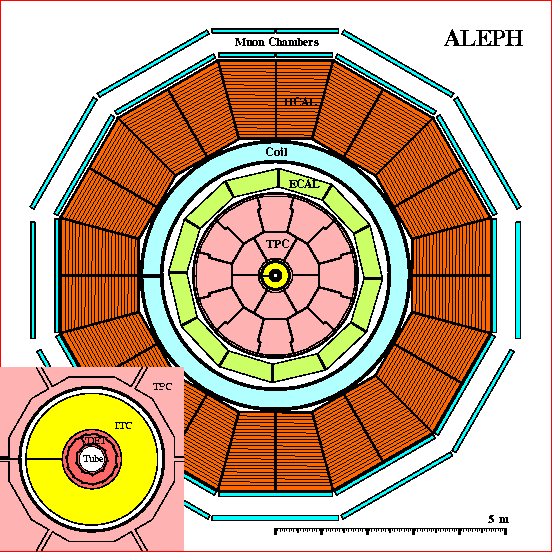 The ALEPH Detector
The ALEPH Detector The ALEPH Detector
The ALEPH DetectorThis is a clickable map, to learn about the parts of the detector click on the part you are interested in. For a more accurate printable view of the detector pick the postscript file: detector.

ALEPH is a particle detector
covering as much of the 4pi solid angle
as possible. It is designed to measure the momenta of charged particles,
to measure the energy deposited in calorimeters by charged and
neutral particles, to identify the three lepton flavors, and to
measure the distance of travel of short-lived particles such as the
tau lepton and the b and c hadrons.
Particular emphasis has been given to
![]() momentum resolution up to the highest energies
(by means of a tracking system in a 1.5 T magnetic field),
momentum resolution up to the highest energies
(by means of a tracking system in a 1.5 T magnetic field),
![]() electron identification (by means of a highly segmented, projective
electromagnetic calorimeter as well as by ionization measurement
in the tracking system),
electron identification (by means of a highly segmented, projective
electromagnetic calorimeter as well as by ionization measurement
in the tracking system),
![]() muon identification (with sufficient absorber to eliminate the hadrons).
muon identification (with sufficient absorber to eliminate the hadrons).
![]() photon resolution (with the fine grain electromagnetic calorimeter).
photon resolution (with the fine grain electromagnetic calorimeter).
The structure of the detector. It is like an onion with the light tracking components inside and the heavy calorimeters around. We can look at the detector starting from the centre, the interaction point. For this, look at the insert at the bottom left of the picture, this is a blow up of the central region.
The tracking involves three detectors:
![]() a vertex detector,
VDET, composed of
two layers of double-sided silicon microstrips,
a vertex detector,
VDET, composed of
two layers of double-sided silicon microstrips,
![]() a drift chamber,
ITC, with
a 30 cm outer radius, and
a drift chamber,
ITC, with
a 30 cm outer radius, and
![]() a time projection chamber,
TPC, with 180 cm outer radius.
a time projection chamber,
TPC, with 180 cm outer radius.
Then the calorimetry proceeds in two stages: electromagnetic and hadronic.
![]() The electromagnetic calorimeter,
ECAL, is a 45 layer lead/proportional chamber sandwich,
The electromagnetic calorimeter,
ECAL, is a 45 layer lead/proportional chamber sandwich,
![]() the hadron calorimeter, HCAL,
is a 23 layer iron/streamer tube sandwich with
total thickness of 120 cm of iron (the magnet return yoke).
the hadron calorimeter, HCAL,
is a 23 layer iron/streamer tube sandwich with
total thickness of 120 cm of iron (the magnet return yoke).
![]() The whole
is surrounded by an additional muon detection system,
MUON, of two double
layers of streamer tubes.
The whole
is surrounded by an additional muon detection system,
MUON, of two double
layers of streamer tubes.
![]() Finally, important for precise cross
section measurement is the highly segmented luminosity calorimeter composed of
twelve-layer tungsten/silicon sandwiches that surround the beam pipe
at each end.
Finally, important for precise cross
section measurement is the highly segmented luminosity calorimeter composed of
twelve-layer tungsten/silicon sandwiches that surround the beam pipe
at each end.